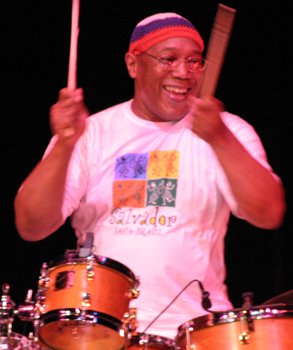| B i o g r a p h y |
 Rare is the drummer who is both influential and essential to a genre, but Billy Cobham (William E. Cobham, Jr.) is
just that in regards to jazz, and consequently to music in general. He
got his start in 1968 with Horace Silver, during which time he became
one of the first percussionists, along with Max Roach and Tony
Williams, to utilize the Electronic Drum Controller. He then performed
with Miles Davis, displaying his ambidextrous drumming on classic
recordings like Bitches Brew, Live-Evil and Jack Johnson. Following, he
joined John McLaughlin in the Mahavishnu Orchestra where he
became an influential force. In addition, Cobham has recorded and
performed the world over with the A-list of jazz and rock greats
including Chick Corea, Tommy Bolin, John Scofield, Count Basie,
the Brecker brothers and fellow percussionist Tito Puente. After
stints of drumming in the service of the Grateful Dead, he toured with
the all-star group Jazz Is Dead in the late 90’s. Cobham’s
most notable offerings to fusion jazz, however, are his own 35
recordings beginning with Spectrum, which was released on Atlantic
Records in 1973 and reissued on compact disc by Rhino Entertainment in
2001 with the DVD due in 2002. Amid the re-release of Spectrum, Cobham
will hit the road on a six-week tour across the United States. Joining
him is Lee Sklar who reprises his role on bass (the legendary bottom
man played on the original recording of Spectrum), Gary Husband on keys
and guitarist Dean Brown.
Rare is the drummer who is both influential and essential to a genre, but Billy Cobham (William E. Cobham, Jr.) is
just that in regards to jazz, and consequently to music in general. He
got his start in 1968 with Horace Silver, during which time he became
one of the first percussionists, along with Max Roach and Tony
Williams, to utilize the Electronic Drum Controller. He then performed
with Miles Davis, displaying his ambidextrous drumming on classic
recordings like Bitches Brew, Live-Evil and Jack Johnson. Following, he
joined John McLaughlin in the Mahavishnu Orchestra where he
became an influential force. In addition, Cobham has recorded and
performed the world over with the A-list of jazz and rock greats
including Chick Corea, Tommy Bolin, John Scofield, Count Basie,
the Brecker brothers and fellow percussionist Tito Puente. After
stints of drumming in the service of the Grateful Dead, he toured with
the all-star group Jazz Is Dead in the late 90’s. Cobham’s
most notable offerings to fusion jazz, however, are his own 35
recordings beginning with Spectrum, which was released on Atlantic
Records in 1973 and reissued on compact disc by Rhino Entertainment in
2001 with the DVD due in 2002. Amid the re-release of Spectrum, Cobham
will hit the road on a six-week tour across the United States. Joining
him is Lee Sklar who reprises his role on bass (the legendary bottom
man played on the original recording of Spectrum), Gary Husband on keys
and guitarist Dean Brown.
At the same time, Cobham has several projects in the works including Drum + Voice (due via Sony) and a range of educational tools he produces through his own company, Creative Multi-Media Concepts. Among the resources is a book, Conundrum, and a slew of Music Minus One interactive CDs which feature selections from Spectrum, where the individual instrument tracks can be muted so that the musician/student can play along, in essence filling in for any key member of the London Jazz Orchestra with whom this project was recorded. The experience is one that Cobham describes as “accessible and yet challenging.” Other titles in the interactive collection include North by Northwest which spotlights contributions by Scandinavian musicians, and the Art of Three, featuring Kenny Barron and Ron Carter in a mainstream jazz presentation. The trio tested this idea throughout Europe in 2001, which was greeted with success, and launched the follow-up project, Art of Four, with Carter returning and bringing in Donald Harrison and James Williams. The results of Cobham's tutorial role, under the umbrella that he calls The Art of Jazz, will be available in the spring of 2002.
As is the case with pioneers, fans that are generations removed find
themselves seeking the roots of the music they currently appreciate.
“People are always rediscovering,” says Cobham. “If
something has come about and they don’t know the foundation or
the history of it, they ask themselves ‘Where’d that come
from?’” In addition to the old-school jazz heads who will
enjoy having Billy Cobham’s recordings in CD format, the new
discs will enable fresh fans, young and old, to discover where he came
from as well as where he is going and how.